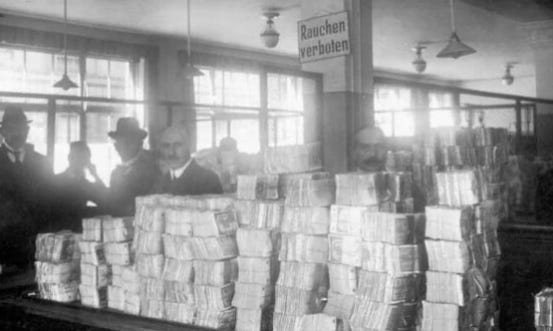When Gold Shot Up To 87 Trillion Marks!
A study of Weimar Germany's horrific hyper-inflationary event and what you can do if this ever happens again.
The topic of this post is gold's reaction in a hyper-inflationary environment. Case in point, the hyper-inflationary money printing of Weimar Germany's central bank in the early 1920s, following the end of WWI. Prior to the 'Great War', as it was known then, Germany was on the classical gold standard in which money printing is fixed by the amount of gold held by a central bank. At the outbreak of war in 1914, Germany went off the gold standard, thereby allowing for unlimited money printing to finance what they believed would be a short lived war.
By the end of 1918 however, the war was finally over and Germany was in ruins. The following year, the Allies met at Versailles, France to negotiate terms of peace, blaming Germany for starting the war and forcing them to pay reparations of 6.6 Billion Pounds, payable at 100 million pounds per year. At that rate, it would take 66 years to pay off this enormous reparations bill.
Before the war, Germany was an economic powerhouse, similar to the Germany we have today. By the time the war was over, Germany's manufacturing base was in ruins. The only way they could pay off these reparations was by turning on the printing presses and print new bank notes.
And print they did!
At first, the inflation was hardly noticed but in 1921, cost of goods slowly began to rise. In January, 1919 one gold ounce could be bought for 170 marks. By January, 1920 one gold ounce cost 1,340 marks. In May of 1920, the gold price actually fell to 966 marks but by September, 1921 gold had shot up to 2,175 marks……
Read the full article for free at my new website, morning-java.com!




